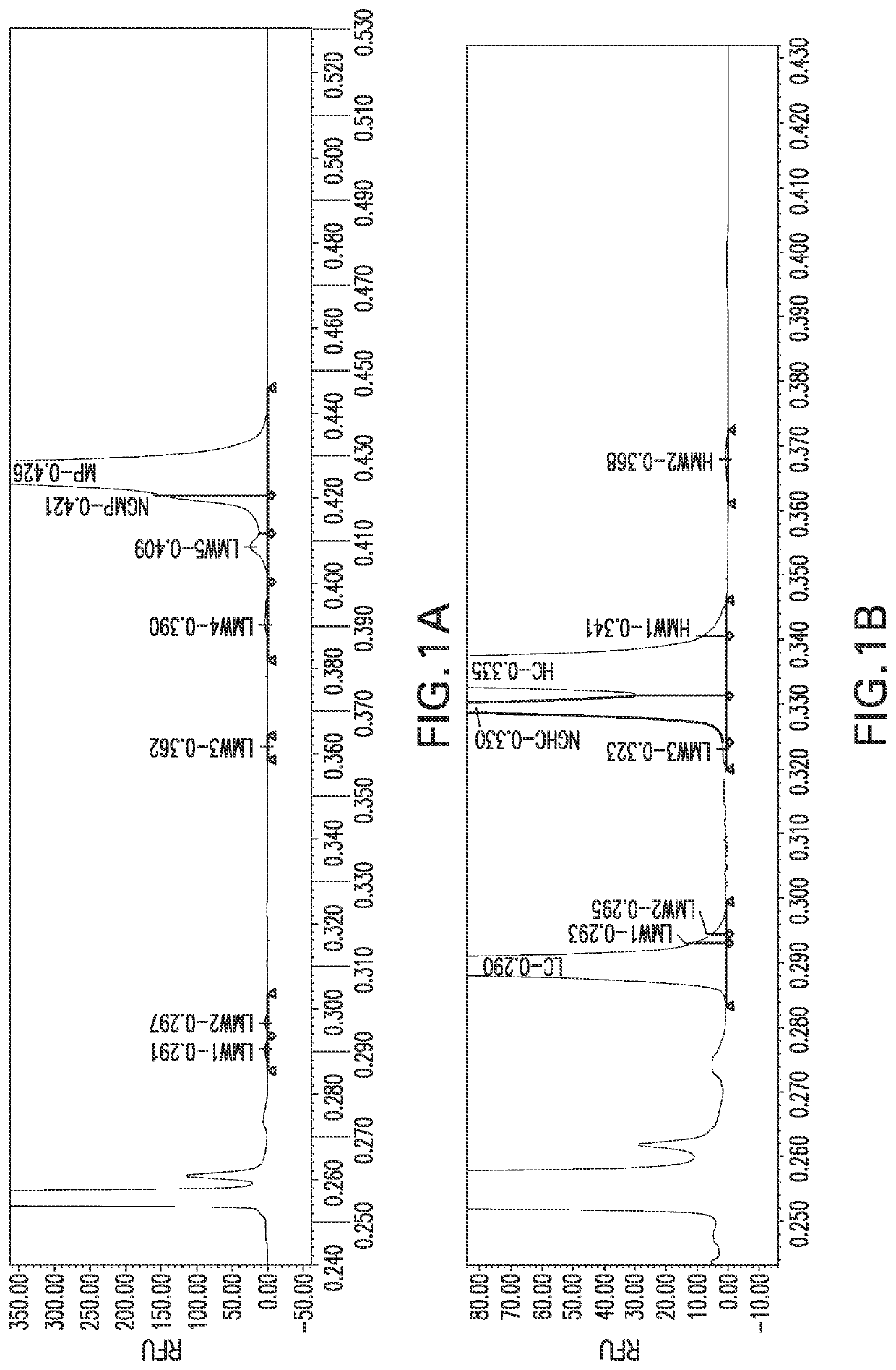Microchip capillary electrophoresis assays and reagents
a microchip and capillary electrophoresis technology, applied in the field of capillary electrophoresis, can solve problems such as prone to assay interference, and achieve the effect of improving the detection of impurities in a protein drug produ
- Summary
- Abstract
- Description
- Claims
- Application Information
AI Technical Summary
Benefits of technology
Problems solved by technology
Method used
Image
Examples
example 1
MCE Assay for Purity and Impurity Analysis of Therapeutic Proteins
Methods and Materials:
[0074]Materials:
[0075]LabChip GXII or LabChip GXII Touch HT and LabChip® HT Protein Express Chip were used for capillary electrophoretic separation and data collection (Perkin Elmer). Non-reducing and reducing denaturing buffers disclosed above were used for the MCE assay.
[0076]Methods:
[0077]Microchip Capillary Electrophoresis (MCE) provides analysis of protein purity and impurities suitable for in-process testing, lot release, and stability indication. Protein samples of casirivimab and imdevimab were prepared by denaturing the sample through heating and addition of lithium dodecyl sulfate (LDS) with either an alkylating (non-reduced) or reducing agent (reduced). The resulting samples were then incubated with an amine ester dye to covalently label any free amine groups. Labeled samples were injected onto a microchip where the application of a current separated the sample components according to ...
example 1a
Non-Reducing Buffer
[0080]The general preparation presented in Table 1 was followed, using in the Sample Preparation Step a non-reducing aqueous electrophoresis sample buffer that contained 166 mM 2-iodoacetamide, 0.81% lithium dodecyl sulfate, and 81 mM sodium phosphate and had a pH of 6. The sample was heated at 75_° C. for 10 minutes. The Sample Labeling step used 5 μM dye solution. The Final Dilution step used 105 μL Dilute Stop Solution.
example 1b
Reducing Buffer
[0081]The general preparation presented in Table 1 was followed, using in the Sample Preparation Step a reducing aqueous electrophoresis sample buffer that contained 0.69% lithium dodecyl sulfate, 69 mM sodium phosphate, and 142 mM dithiothreitol, and had a pH of 9. The sample was heated at 75° C. for 10 minutes. The Sample Labeling step used 5 μM dye solution. The Final Dilution step used 105 μL Dilute Stop Solution.
TABLE 2General sample preparation method for a second MCE assay.Sample PreparationNRR40 μl 0.2 mg / mL Sample40 μl 0.2 mg / mL Sample10 μL NR Buffer10 μL R BufferMix, centrifuge, heat at Specified Temperature for 10 minutesSample Labeling5 μL Denatured Sample16 μL 16 μM PICO dyeMix, centrifuge, heat at 35° C. for 15 minutesFinal Dilution5 μL Labeled Sample105 μL Dilute Stop Solution or Dilute SolutionSeparation MethodHT PICO Protein Express 200
Buffers
[0082]Stock solutions of 200 mM Sodium Phosphate Monobasic Monohydrate, 200 mM Sodium Phosphate Dibasic Hepath...
PUM
| Property | Measurement | Unit |
|---|---|---|
| pH | aaaaa | aaaaa |
| pH | aaaaa | aaaaa |
| concentration | aaaaa | aaaaa |
Abstract
Description
Claims
Application Information
 Login to View More
Login to View More - R&D
- Intellectual Property
- Life Sciences
- Materials
- Tech Scout
- Unparalleled Data Quality
- Higher Quality Content
- 60% Fewer Hallucinations
Browse by: Latest US Patents, China's latest patents, Technical Efficacy Thesaurus, Application Domain, Technology Topic, Popular Technical Reports.
© 2025 PatSnap. All rights reserved.Legal|Privacy policy|Modern Slavery Act Transparency Statement|Sitemap|About US| Contact US: help@patsnap.com

